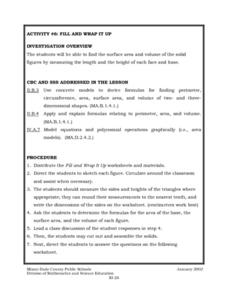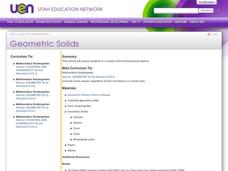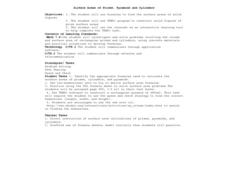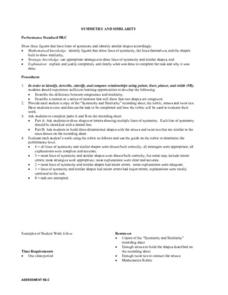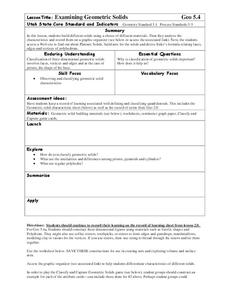Curated OER
Countdown Challenge: Platonic Solids - Part II
In this platonic solid worksheet, students observe five solids and draw a net of each three-dimensional figure. Students examine a tetrahedron, an octahedron, an icosahedron, a cube, and a dodecahedron. This is a one-page worksheet.
Curated OER
Fill and Wrap It Up
Students find the surface area and volume of the solid figures by measuring the length and the height of each face and base. They use concrete models to derive formulas for finding perimeter, circumference, area, surface area, and volume...
World Wildlife Fund
Arctic Shapes
In a two-part worksheet, young geometers examine 3-D shapes and describe their attributes in a table. They will be able to draw the shape and name the number of vertices, faces, and edges. In the second part, individuals explore...
Curated OER
Living in a Geometrical World
Students participate in a series of hand-on, online, and multimedia activities to examine 2 dimensional and 3 dimensional shapes. They describe common geometric solids. They construct rectangular prisms using straws and ribbon.
Annenberg Foundation
Geometry 3D Shapes: Euler's Theorem
How do you get a theorem named after you? Euler knows what it takes! The third lesson of five asks pupils to use an interactive activity to compare the faces, vertices, and edges of seven different three-dimensional solids. They use...
Curated OER
Hands On: Make Solids Using Nets
In this making solid using nets practice worksheet, students sharpen their problem solving skills as they solve 6 story problems.
Curated OER
Geometric Solids
Students identify and create simple geometric shapes and describe simple spatial relationships. Through discussion, hands-on activities and show and tell, they identify geometric solids in real life and create graphs of commonly found...
Curated OER
Chopping Cubes
Middle schoolers work in small groups to make various geometric solids with Play-Doh. They use fishing line to make cuts and observe the shapes of the cross-sections. Pupils complete an assessment in which they answer questions such as:...
Annenberg Foundation
Geometry 3D Shapes: Surface Area and Volume
Whether you wrap it or fill it, you're using geometric concepts. Classmates use an interactive approach to learn how to find volume and surface area of cylinders and prisms in the second lesson in a five-part series. The online lesson...
Curated OER
Net (Cone)
In this cone worksheet, students cut out, fold and assemble a solid figure of a cone by using the net provided on this page. No written directions are given.
Curated OER
Surface Areas of Prisms, Pyramids and Cylinders
Students identify and use appropriate formulas to find surface areas of solid figures, practice using formula sheet to solve textbook problems, construct solid figures of given surface area using TABS+ software program, and use Internet...
Curated OER
Math: Symmetry and Similarity
Students describe the differences between congruence and similarity. After explaining the motions that indicate congruency of two shapes, they complete worksheets to draw lines of symmetry and similar shapes. With straws and twist...
Curated OER
Area of Complex Figures
Fifth graders use formulas for calculating areas of squares and rectangles to find area of complex figure, compare their own ideas with their classmates' ideas, and recognize that there are multiple methods for finding area of complex...
Curated OER
Free Printables: Nets (3D Models)
For this 3D shapes worksheet, students cut out the 3D shape on the page and fold on the lines to create the correct shape. The worksheet states which shape should be build with the cut-out.
EngageNY
How Do 3D Printers Work?
If we stack up all the cross sections of a figure, does it create the figure? Pupils make the connection between the complete set of cross sections and the solid. They then view videos in order to see how 3D printers use Cavalerie's...
Florida Center for Instructional Technology
Two for One Box Company
Given a box of certain dimensions, young mathematicians must determine if a box that is twice as big, actually holds twice as much. This is a brain-teaser of a problem. The worksheet provides a handy table that has learners calculate the...
Curated OER
Two for One Box Company
Here is a challenging and thought-provoking math worksheet. In it, learners work together to construct a variety of boxes of different sizes to see if doubling the size of a box really means it can hold twice as much stuff as the...
Curated OER
Geometry Journal: Classifying Solids
In this geometry worksheet, 10th graders respond to journal prompts related to prisms and classifying solid shapes. The two page worksheet contains nine questions. Answers are included.
Curated OER
More Prisms/Nets
Pupils calculate the volume and surface are of three-dimensional shapes. In this geometry lesson, students use the nets to prove their calculations of shapes. They identify the different parts of a solid using the nets.
Curated OER
Which container holds a larger amount of popcorn?
What does popcorn have to do with math? Seventh grade mathematicians are provided an opportunity to develop a conceptual understanding of the formula for volume and to use it as a tool to solve problems. The lesson begins with a...
Curated OER
Examining Geometric Solids
Students explore geometry by completing a math worksheet in class. In this shape identification lesson, students identify the characteristics associated with 15 solid geometric shapes. Students identify patterns between vertices, edges...
Curated OER
2D Polygons and 3D Nets
Students compare and contrast two dimensional polygons and three dimentional nets by examining the differences in drawings. They create three dimensional shapes and label the faces, edges, and vertices. After creating the shapes, they...
Curated OER
Investigating Nets and Polyhedra
Fifth graders create a net for a given polyhedron. They determine the corresponding polyhedron for a given net. Students investigate several polyhedra (cube, tetrahedron, and one of their choosing) and their corresponding nets. They...
Curated OER
Rectangular Prism Net
In this geometry worksheet, students cut out a rectangular prism net. They cut along the dotted lines as indicated the scissors icon, and fold the piece along the solid lines to form the three-dimensional shape. There are no directions...

